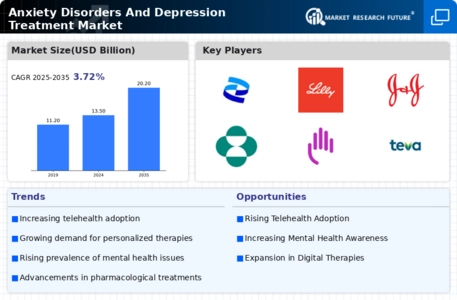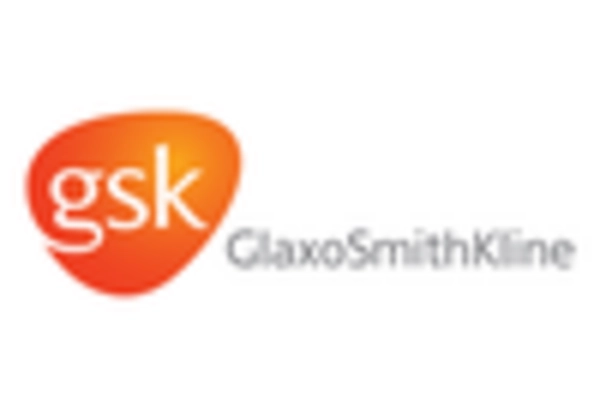Advancements in Treatment Modalities
Innovations in treatment modalities are reshaping the Anxiety Disorders and Depression Treatment Market. The emergence of novel pharmacological agents, such as serotonin-norepinephrine reuptake inhibitors (SNRIs) and atypical antipsychotics, has broadened the therapeutic landscape. Additionally, non-pharmacological approaches, including cognitive behavioral therapy (CBT) and mindfulness-based interventions, are gaining traction. These advancements not only enhance treatment efficacy but also cater to diverse patient needs, thereby increasing market appeal. The integration of technology, such as teletherapy and mobile health applications, further supports this trend, making treatment more accessible. As a result, the Anxiety Disorders and Depression Treatment Market is likely to witness robust growth driven by these innovative treatment options.
Rising Prevalence of Anxiety and Depression
The increasing prevalence of anxiety disorders and depression is a primary driver of the Anxiety Disorders and Depression Treatment Market. Recent estimates indicate that approximately 1 in 5 adults experience mental illness each year, with anxiety disorders affecting around 31.1% of adults at some point in their lives. This growing incidence necessitates effective treatment options, thereby propelling market growth. As awareness of mental health issues expands, more individuals seek help, leading to a surge in demand for therapeutic interventions. The Anxiety Disorders and Depression Treatment Market is thus positioned to expand significantly, as healthcare providers and pharmaceutical companies respond to this urgent need for accessible and effective treatment solutions.
Growing Acceptance of Mental Health Treatment
The growing acceptance of mental health treatment is transforming the landscape of the Anxiety Disorders and Depression Treatment Market. Societal stigma surrounding mental health issues is gradually diminishing, leading to more individuals seeking help. This cultural shift is reflected in increased utilization of mental health services, with a reported rise in therapy sessions and medication prescriptions. As more people recognize the importance of mental well-being, the demand for effective treatment options escalates. This trend not only enhances the visibility of the Anxiety Disorders and Depression Treatment Market but also encourages healthcare providers to expand their offerings, ultimately driving market growth.
Increased Investment in Mental Health Research
The surge in investment for mental health research is a significant catalyst for the Anxiety Disorders and Depression Treatment Market. Governments and private organizations are increasingly recognizing the importance of mental health, leading to enhanced funding for research initiatives. For instance, funding for mental health research has seen a notable increase, with billions allocated annually to explore new treatment avenues and improve existing therapies. This financial commitment fosters innovation and encourages the development of more effective treatment options. Consequently, the Anxiety Disorders and Depression Treatment Market stands to benefit from these advancements, as new findings translate into improved therapeutic strategies and increased market opportunities.
Regulatory Support for Mental Health Initiatives
Regulatory support for mental health initiatives plays a crucial role in shaping the Anxiety Disorders and Depression Treatment Market. Governments are implementing policies aimed at improving access to mental health care, including legislation that mandates insurance coverage for mental health services. Such regulatory frameworks facilitate the integration of mental health treatment into primary care settings, thereby increasing accessibility for patients. Furthermore, initiatives promoting mental health awareness and education contribute to a more informed public, encouraging individuals to seek treatment. As these supportive measures continue to evolve, the Anxiety Disorders and Depression Treatment Market is likely to experience sustained growth, driven by enhanced access and increased patient engagement.


















Leave a Comment